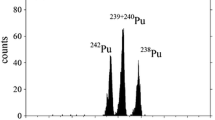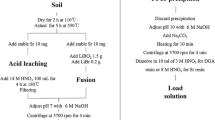Abstract
A simple method for the determination of the radon emanation fraction was studied using a liquid scintillation counter. The radon activity of the gaseous phase in a closed container was measured 1 day and 35 days after sealing and used to calculate the radon emanation fraction. Radon leakage from the container was investigated using a 226Ra radioactive standard solution (SRM4967, NIST) to plot a radon growth curve. The method was applied to materials that typically contain a high level of radium, such as phosphogypsum, phosphate fertilizer and a rock sample. The effect of temperature on the radon emanation fraction from the materials was investigated at 0, 10, 20, 30 and 40 °C. It was found that there is a linear correlation (R 2 = 0.746 − 0.946) between temperature and the emanation fraction. Within the temperature range, the radon emanation fractions were 0.241–0.466 for phosphogypsum, 0.225–0.351 for phosphate fertilizer and 0.154–0.351 for the rock sample.




Similar content being viewed by others
References
U.S. Environmental Protection Agency (2002) National Emission Standards for Hazardous Air Pollutants. Subpart R. U.S. Environmental Protection Agency, USA
Mun KJ, Hyoung WK, Lee CW (2007) Basic properties of non sintering cement using phosphogypsum and waste lime as activator. Constr Build Mater 21:1342–1350
Tayibi H, Choura M, Lόpez FA, Alguacil FJ, Lόpez-Delgado A (1009) Environmental impact and management of phosphogypsum. Environ Manag 90:2377–2386
Lysandrou M, Charalambides A, Pashalidis I (2007) Radon emanation from phosphogypsum and related mineral samples in Cyprus. Radiat Meas 42:1583–1585
Degirmenci N (2008) The using of waste phosphogypsum and natural gypsum in adobe stabilization. Constr Build Mater 22:1220–1224
Yang J, Liu W, Zhang L, Xiao B (2009) Preparation of load-bearing building materials from autoclaved Phosphogypsum. Constr Build Mater 23:687–693
Jang YN et al. (2009) Fundamental study on sequestration of CO2 by mineral carbonation. KIGAM report GP2009-002-2009(1)
Lackner KS, Butt DP, Wendt CH (1997) Progress on binding CO2 in mineral substrates. Energy Convers Manag 38:S259–S264
Rutherford PM, Dudas MJ, Samek RA (1994) Environmental impacts of phosphogypsum. Sci Total Environ 149:31–38
Rogers VC, Nielson KK (1991) Multiphase radon generation and transport in porous materials. Health Phys 60(6):807–815
Faheen M, Matiullah (2008) Radon exhalation and its dependence on moisture content from samples of soil and building materials. Radiat Meas 43:1458–1462
Stranden E, Kolstad AK, Lind B (1984) The influence of moisture and temperature on radon exhalation. Radiat Protect Dosim 7(1–4):55–58
Iskandar D, Yamazawa H, Iida T (2004) Quantification of the dependency of radon emanation power on soil temperature. Appl Radiat Isot 60:971–973
Petropoulos NP, Anagnostakis MJ, Simopoulos SE (2002) Photon attenuation, natural radioactivity content and radon exhalation rate of building materials. Environ Radioact 61:257–269
Stoulos S, Manolopoulou M, Papastefanou C (2004) Measurement of radon emanation factor from granular samples: effects of additives in cement. Appl Radiat Isot 60:49–54
Ferry C, Richon P, Beneito A, Cabrera J, Sabroux JC (2002) An experimental method for measuring the radon-222 emanation factor in rocks. Radiat Meas 35:579–583
Stoulos S, Manolopoulou M, Papastefanou C (2003) Assessment of natural radiation exposure and radon exhalation from building materials in Greece. Environ Radioact 69:225–240
Acknowledgments
This research was supported by a grant for basic research project from the Korea Institute of Geosciences and Mineral Resources funded by the Ministry of Knowledge Economy (MKE) of Korea. The authors would like to thank MKE for the financial support.
Author information
Authors and Affiliations
Corresponding author
Rights and permissions
About this article
Cite this article
Lee, K.Y., Cho, S.Y., Yoon, Y.Y. et al. Determination of the radon emanation fraction from phosphogypsum using LSC. J Radioanal Nucl Chem 291, 197–200 (2012). https://doi.org/10.1007/s10967-011-1306-5
Received:
Published:
Issue Date:
DOI: https://doi.org/10.1007/s10967-011-1306-5




